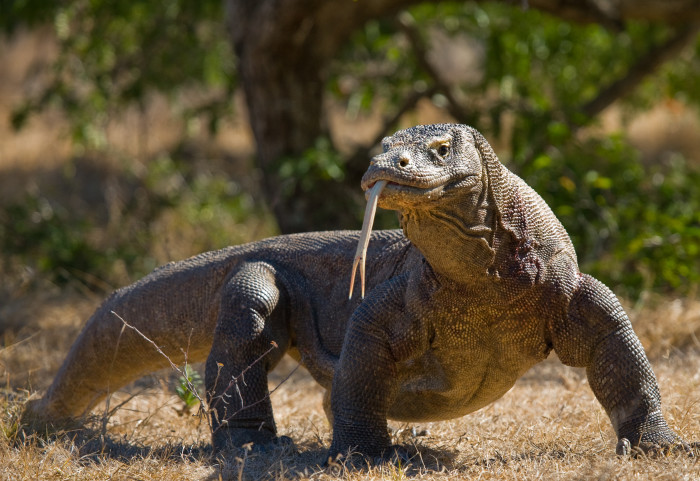Islands give rise to evolutionary giants and dwarfs

Komodo dragons grew large on several Indonesian islands
Animals living on islands tend to evolve into either giants or dwarfs in relation to their continental ancestors, reveals a new study.
The analysis of more than a thousand land animal species shows that the so-called ‘island rule’ holds true for mammals, birds, reptiles, and, to a lesser extent, amphibians.
Most so-called ‘rules’ in evolution turn out to be fairly limited in their scope and predictive power. From that perspective our results are exciting. Dr Joseph Tobias
The research, published today in Nature Ecology and Evolution, was carried out by a team of scientists based at several European institutions, including Imperial College London.
The island rule describes the hypothetical tendency for small species to become much larger while large species tend to become much smaller in comparison with mainland relatives when they evolve separately on islands.
Examples of ‘shrinking’ animals include dwarf hippos and elephants, which inhabited many Mediterranean islands around 10,000 years ago. At the other end of the scale, small animals becoming larger include the St Kilda field mouse (twice the size of its mainland ancestor), the infamous dodo of Mauritius (a giant pigeon), and the Komodo dragon.
Shaping evolution on islands
However, whether the island rule is a valid evolutionary rule has been hotly debated in the literature, with conflicting results across many studies, which has led some researchers to conclude that the famous examples above are cherry-picked and not representative of general patterns.

The new research, led by Dr Ana Benítez-Lopez from Doñana Biological Station, Spain, analysed studies of body size changes in 2,500 populations of over 1,000 species of land animals.
As well as confirming the island rule, the study also indicates that the magnitude of island (or ‘insular’) dwarfism and gigantism is partly controlled by island size and isolation, with more pronounced effects in smaller, more remote islands for mammals and reptiles. The team also found that climate and seasonality shaped how evolution proceeds on islands.
Not just an evolutionary coincidence
Dr Benítez-Lopez said: “We gathered thousands of measurement data from museum and live specimens to address via a modern statistical analysis a long-standing question in evolutionary ecology.

"This wealth of data provided us with the unique opportunity to rigorously demonstrate that insular gigantism and dwarfism across vertebrates is a generalized pattern and not just an evolutionary coincidence.”
The findings suggest that features of island systems, such as limited resources and space, are major factors leading to large animals becoming smaller, whereas features such as lower competition and the absence of predators could release constraints on body size for normally smaller animals.
Dr Joseph Tobias, from the Department of Life Sciences at Silwood Park, Imperial College London, said: “Most so-called ‘rules’ in evolution turn out to be fairly limited in their scope and predictive power. From that perspective our results are exciting, suggesting that ecological processes can explain unusual evolutionary outcomes on islands worldwide.”
-
‘The island rule explains consistent patterns of body size evolution in terrestrial vertebrates' by Ana Benítez-López et al. is published in Nature Ecology & Evolution.
Komodo dragon image credit: GUDKOV ANDREY / Shutterstock
Dwarf elephant skeletons image credit: Danny Ye / Shutterstock
Dodo image credit: Daniel Eskridge / Shutterstock
Article text (excluding photos or graphics) © Imperial College London.
Photos and graphics subject to third party copyright used with permission or © Imperial College London.
Reporter
Hayley Dunning
Communications Division